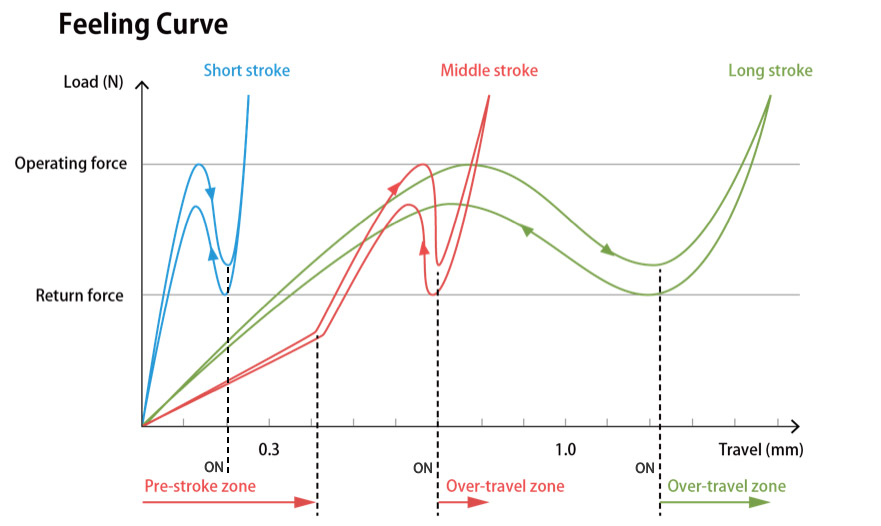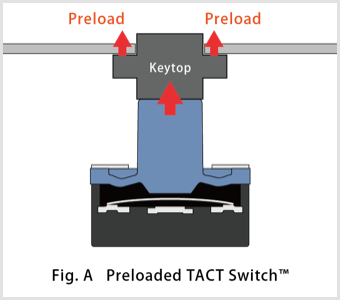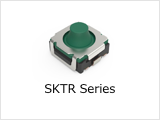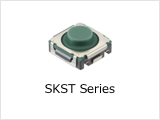In the previous installment, we explained the structure of a middle-stroke type of TACT Switch™. In this article, we look at the feel and effects of the over-travel and pre-stroke that the structure creates.
View the previous article here.
Over-travel and Pre-stroke
In the previous article, we explained that the compression of rubber in a long-stroke or middle-stroke type TACT Switch™ creates an over-travel after the contact closes. There are also some middle-stroke types with a pre-stroke prior to movement by the moving contact. As feeling curves, they look like this.

With a short-stroke type TACT Switch™, a sharp tactile click occurs as the metal dome inverts, but there is no additional travel once the contact closes. It feels like your finger is bumping into something, which can be tiring when operating the switch over long periods. Over-travel is the cushioning effect on this impact achieved using rubber. With middle-stroke and long-stroke types of TACT Switch™, the push feel experienced by the user can be fine-tuned by adjusting this over-travel. Alps Alpine's middle-stroke TACT Switch™ lineup also includes series with a pre-stroke zone, meaning users do not have to apply a lot of force at the start of the push, but are instead gradually drawn into pushing harder.
Examples of Over-Travel and Pre-stroke Structures

In a middle-stroke TACT Switch™, over-travel occurs when the rubber stem (pusher) is compressed. The feel of the switch when it is pushed can be altered by adjusting the hardness of the rubber.
Pre-stroke, on the other hand, is created by inserting a gap between rubber stem and metal dome. At the start of the push, until the stem makes contact with the metal dome, only a small amount of force is required, equivalent to the elasticity of the rubber. After making contact with the metal dome, the normal amount of force is required.
The internal structures of such switches and the relationship with the feeling curve are as illustrated.

Use of Over-Travel to Increase Tolerance of Housing Stopper Design
When inserting a stopper for a switch as part of the end product design, having an over-travel zone increases the design tolerance.

Using a Pre-stroke Design to Prevent Rattling

Rattling is noise caused by parts making contact with one another when vibrations are applied to the product. Rattling as a result of play between parts can be actively prevented using a pre-stroke structure. Making use of the elasticity of the rubber stem in a pre-stroke state, it is possible to prevent noise from vibrations in end products by preloading switches with keytops already wedged in place, which cancels out any play among TACT Switch™, keytop and housing.
TACT Switch™ Varieties with Pre-stroke
Alps Alpine currently supplies the following middle-stroke TACT Switch™ varieties with pre-stroke designs.

Compact middle stroke type
realizing a clear operating feel.
Middle stroke type realizing low
operation sound and a clear
operating feel.
Compact and quiet middle
stroke type.
Switch with 0.9mm stroke
realizing a refined operating
feel.
So far we have explained the structure of TACT Switch™ products and the feel and effects they create. Next time, we will look at ways to minimize operating sound.































